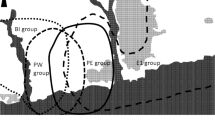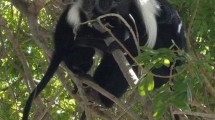Abstract
Rejections of infants among non-human primates occasionally occur in the wild as well as in captive settings. Controlled adoptions of orphans and introductions of individuals into new groups are therefore sometimes necessary in captivity. Consequently, behavioral research on integration procedures and on the acceptance of infants by adoptive mothers is much needed. In this study, the introduction and subsequent adoption were examined in an 18-month-old hand-reared chimpanzee (Pan troglodytes). The infant was introduced into an age/sex-diversified social group of conspecifics at Furuvik Zoo, Gävle, Sweden, and continuous focal data was collected during the final stage of integration, including infant care exhibited by the group members and the infant’s secure base behavior. The infant was successfully integrated into the group and engaged in positive social interactions with all group members. An adult primiparous female chimpanzee formed a bond resembling a mother–infant relationship with the infant, which continues to be maintained at publication. However, the female initially showed very limited interest in the infant. It was, in fact, two other younger female group members that exhibited most infant care. The infant’s secure base behavior patterns indicate that she adapted well to the new circumstances in the chimpanzee group as the integration progressed. This provides evidence that a final adopter does not necessarily initially show maternal interest and that there can be flexibility in maternal behavior in adult chimpanzee females. Moreover, the methods applied employing gradual familiarization with all the group members and the use of an integration enclosure, may have contributed to a successful result. These findings extend our knowledge of introduction procedures in captivity as well as provide information on foster mother–infant attachment in chimpanzees.




Similar content being viewed by others
References
Abello MT, Colell M (2009) Early introduction of hand-reared Gorillas Gorilla gorilla to conspecifics at Barcelona Zoo: general procedures and three case studies. Int Zoo Yearb 43:159–175
Ainsworth MDS, Bell SM (1970) Attachment, exploration, and separation: illustrated by the behavior of one-year-olds in a strange situation. Child Dev 41:49–67
Altmann J (1974) Observational study of behavior: sampling methods. Behaviour 49:227–267
Bard KA (1994) Evolutionary roots of intuitive parenting: maternal competence in chimpanzees. Early Dev Parenting 3:19–28
Bard KA, Nadler RD (1983) The effect of peer separation in young chimpanzees (Pan troglodytes). Am J Primatol 5:23–37
Bashaw M, Gullott R, Gill E (2009) What defines successful integration into a social group for hand-reared chimpanzee infants? Primates 51:139–147
Berman CM (1982) The social development of an orphaned rhesus infant on Cayo Santiago: male care, foster mother-orphan interaction and peer interaction. Am J Primatol 3:131–141
Bloomsmith MA, Kuhar C, Baker K, Lambeth S, Brent L, Ross SR, Fritz J (2003) Primiparous chimpanzee mothers: behavior and success in a short-term assessment of infant rearing. Appl Anim Behav Sci 84:235–250
Boesch C, Bolé C, Eckhardt N, Boesch H (2010) Altruism in forest chimpanzees: the case of adoption. PLoS One 5:e8901
Bowlby J (1969) Attachment and loss: attachment, vol 1. Basic Books, New York
Bowlby J (1973) Attachment and loss: separation, vol 2. Basic Books, New York
Brent L, Kessel AL, Barrera H (1997) Evaluation of introduction procedures in captive chimpanzees. Zoo Biol 16:335–342
Cleveland J, Snowdon CT (1984) Social development during the first twenty weeks in the cotton-top tamarin (Saguinus o. oedipus). Anim Behav 32:432–444
deWaal F (1982) Chimpanzee politics. Harper & Row, New York
Dolhinow P, DeMay MG (1982) Adoption: the importance of infant choice. J Hum Evol 11:391–420
Fragaszy D, Bard K (1997) Comparison of developmental and life history in Pan and Cebus. Int J Primatol 18:683–701
Goodall J (1986) The chimpanzees of Gombe: patterns of behavior. The Belknap Press of Harvard University Press, Cambridge
Holman SD, Goy RW (1980) Behavioral and mammary responses of adult female rhesus to strange infants. Horm Behav 14:348–357
Jendry C (1996) Utilization of surrogates to integrate hand-reared infant gorillas into an age/sex diversified group of conspecifics. Appl Anim Behav Sci 48:173–186
Meder A (1990) Integration of hand-reared gorillas into breeding groups. Zoo Biol 9:157–164
Miller LC, Bard KA, Juno CJ, Nadler RD (1986) Behavioral responsiveness of young chimpanzees (Pan troglodytes) to a novel environment. Folia Primatol (Basel) 47:128–142
Nishida T (1983) Alloparental behavior in wild chimpanzees of the Mahale Mountains, Tanzania. Folia Primatol (Basel) 41:1–33
Nishida T, Corp N, Hamai M, Hasegawa T, Hiraiwa-Hasegawa M, Hosaka K, Zamma K (2003) Demography, female life history, and reproductive profiles among the chimpanzees of Mahale. Am J Primatol 59:99–121
Okamoto-Barth S, Tanaka M, Kawai N, Tomonaga M (2007) Looking compensates for the distance between mother and infant chimpanzee. Dev Sci 7:172–182
Palthe T, van Hooff J (1975) A case of the adoption of an infant chimpanzee by a suckling foster chimpanzee. Primates 16:231–234
Pazol K, McDonald S, Baker K, Smuts B (1998) Placing hand-reared chimpanzees (Pan troglodytes) into adult social groups: a technique for facilitating group integration. Lab Prim Newsl 37:11–13
Pusey AE (1983) Mother–offspring relationships in chimpanzees after weaning. Anim Behav 31:363–377
Thierry B, Anderson J (1986) Adoption in anthropoid primates. Int J Primatol 7:191–216
Tutin C (1994) Reproductive success story: variability among chimpanzees and comparisons with gorillas. In: Wrangham R, McGrew W, de Waal F, Heltne P (eds) Chimpanzee cultures. Harvard University Press, Cambrigde, pp 181–194
Uehara S, Nyundo R (1983) One observed case of temporary adoption of an infant by unrelated nulliparous females among wild chimpanzees in the Mahale Mountains, Tanzania. Primates 24:456–466
Wroblewski EE (2008) An unusual incident of adoption in a wild chimpanzee (Pan troglodytes) population at Gombe National Park. Am J Primatol 70:995–998
Acknowledgments
We would like to thank Furuvik Zoo and Ing-Marie Persson for permission to conduct the study and for invaluable expertise. We are also grateful to the animal care staff at the zoo for their assistance. We also thank Mathias Osvath for his input in the beginning of the project as well as Björn Rogell and Paolo Innocenti for comments on the manuscript. Our appreciation is also extended to the reviewers, Kim Bard and Naruki Morimura. Research protocols reported in this article complied with the ethical standards in the treatment of the animals with the guidelines laid down by the Primate Society of Japan, NIH (US), EC Guide for animal experiments, as well as with all national institutional and government regulations regarding ethical treatment of our study subjects.
Author information
Authors and Affiliations
Corresponding author
Electronic supplementary material
Below is the link to the electronic supplementary material.
10329_2012_319_MOESM1_ESM.jpg
Online Resource Photo to the left shows the integration enclosure (to the right in the photo) which is interconnected with the chimpanzee enclosures with an entry only the infant could fit through. The photo to the right shows how JF looks through the entry into the integration enclosure where the infant and the human caregiver were located during the four first weeks. (JPEG 507 kb)
About this article
Cite this article
Thunström, M., Persson, T. & Björklund, M. Integration of a hand-reared chimpanzee (Pan troglodytes) infant into a social group of conspecifics. Primates 54, 13–19 (2013). https://doi.org/10.1007/s10329-012-0319-1
Received:
Accepted:
Published:
Issue Date:
DOI: https://doi.org/10.1007/s10329-012-0319-1




